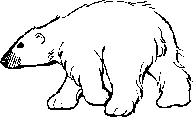NOTE: the free printable Templates are found at the bottom of this page.

Polar Bear, Polar Bear What Do You Hear?

The sequel to Brown Bear, Brown Bear What Do You See?
About the story:
The repetition and colorful illustrations in this classic picture book by Bill Martin Jr, make it a favorite of many children. On each page, we meet a new animal who helps us discover which creature will show up next and allows us to imagine the different sounds each animal makes.
We have lots of animal crafts made from toilet paper rolls, paper, and other materials. You can look through them to find a few bears, a few frogs, a bird, horse, dog, cat, sheep, etc. I'm not going to relist them all here.
In this section I've put together some simple pages to go with the story. You can use them in a number of ways:
Use the sheets as... COLORING PAGES
- simply print the black and white version of each page and allow the children to color them.
- How much do they remember: provide the child with all the colors of crayons they will need the to complete the pages, but allow them to try to remember what color each animal should be.
- Color recognition: For younger children, you may want to guide them a bit more, focusing on color recognition instead of memory. Give them a variety of crayons and instruct them to color the bear brown, the bird red, etc.
- Animal sounds: As you color the pictures, talk about each animal. What sound does the animal make? Where does the animal live? Has the child ever seen that animal?
- Writing: older children can write the color and animal at the bottom of their coloring pages (ex: POLAR BEAR). Or, for slightly younger children who are starting to read but cannot yet write, have an adult write each animal on a slip of paper. Allow the children to pick out the proper slips and glue it to their coloring page.
Use the sheets as... PUPPETS
- Either complete the black and white sheets as coloring pages (see
above)
OR - print the black and white sheets on appropriate colored construction
paper
OR - print the color pages
- Cut out each animal and tape it to a popsicle stick or an unsharpened pencil.
- If working with a group of children, each one can be a certain
animal.
- When their part of the story comes up, they can wiggle around the puppet and either chant their section of the story or make the animal sound.
- You can have an animal parade... Line the children up in the order they are mentioned in the story and let them march around the room, waving their puppets.
- Animal sounds: As you color the pictures, talk about each animal.
What sound does the animal make? Where does the animal live? Has the
child ever seen that animal?
Use the sheets as... FELT BOARD CHARACTERS
- Either complete the black and white sheets as coloring pages (see
above)
OR - print the black and white sheets on appropriate colored construction
paper
OR - print the color pages
- You can cover with clear contact paper or laminate if you want them to last longer.
- Cut out each page.
- Cut out a small piece of coarse sandpaper and tape or glue it on the back of each animal (if you laminated, it will need to be a larger piece of sandpaper). The sandpaper will allow the characters to stick on your felt board.
- If working with a group, give each child an animal. As you read the story, have the children bring up the appropriate animals and put them on the board.
- Animal sounds: As you color the pictures, talk about each animal. What sound does the animal make? Where does the animal live? Has the child ever seen that animal?
Templates (in order of appearance in the story):
- close template window when done printing to return to this screen.
- change your page margins to zero (FILE, PAGE SETUP or FILE, PRINTER SETUP in most browsers). See print help for more info.
| POLAR BEAR LION HIPPOPOTAMUS FLAMINGO ZEBRA BOA CONSTRICTOR ELEPHANT LEOPARD PEACOCK WALRUS ZOOKEEPER CHILDREN |
color |
B&W (B&W |
Print friendly version of these instructions